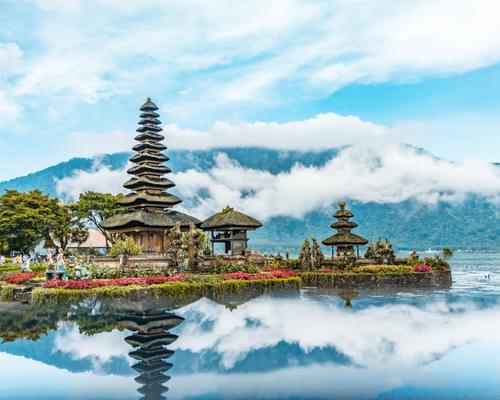About Besakih Temple Tour
Besakih Temple History
The Besakih temple history dates back to more than 1000 years, during the times of the megalithic eras, which is evident in the ancient section of Pura Batu Madeg or the Temple of the Standing Stone here. This section is built around a central rock from those times. According to legends, it is believed that Sri Markandeya, a Javanese priest, was the founder of Besakih, and founded the temple around the 10th century.
It was in 1343, after the Javanese Maha Pandits conquered Bali, that the Besakih Temple gained a lot of religious importance, and became the central temple of the region, especially to the Gelgel and Klungkung courts. The story of how it was founded and rebuilt is also mentioned in several inscriptions and ancient manuscripts. This includes The Babad Gunung Agung, The Journey of Sri Markandeya or the Markandeya Purana, the Penempahan Inscription, the Belanjong Inscription, Gaduh Sakti Inscription and more.
Besakih Temple Highlights
During your Besakih temple tour, one of the main highlights that you can witness inside the temple, is the Pura Penataran Agung, which is also the largest temple here, and has different areas which represent the 7 layers of the universe
Another highlight of the temple complex is the Pura Pangubengan, which offers some of the most beautiful views of the entire region
Located towards the east of Pura Pangubengan is Pura Batu Tirtha, where holy water is sourced for the karya agung ceremonies in the temple and the nearby villages
Another one of the major highlights of the Besakih temple tour is the shrine of Meru Tumpang Sebelas, which is home to the central stone of batu ngadeg, and is the place where Lord Vishnu supposedly descended
Pura Gua, located on the eastern side of the temple, is the place where you can admire the beautiful dragon deity of the Besakih Temple
Located in the southern areas of the temple is the Setra Agung burial ground, where you can find a myriad of ancient and sacred stone statues in the form of the Garuda bird
Know Before You Go
Location:The Besakih Temple is located at:Jl. Gunung Mas No. Ds, Besakih, Kec. Rendang, Kabupaten Karangasem, Bali 80863, Indonesia
Opening Hours:While the temple complex remains open 24 hours a day for worship and praying purposes, the Besakih temple timings for sightseeing and tourist visits is restricted between 08:00 a.m. to 05:00 p.m.
How to Reach- Besakih Temple is located in the north western region of Bali, in close proximity to Mount Agung, the highest peak in the island. - With no public transportation available to get to the temple directly, the best way to reach Pura Besakih is by renting a taxi cab, or driving a car.
Entrance FeeThe entrance fee for the Besakih Temple is IDR 60,000 for adults, and IDR 30,000 for children.
FAQs
Why is the Besakih Temple known as the mother temple of Bali?
The Besakih Temple is known as the Mother Temple of Bali for multiple reasons. In addition to housing at least 86 other temples, like the Great Temple of State, the Besakih Temple has also existed for more than 1,000 years, which makes it one of the oldest temples in the entire island. Additionally, it is the largest, holiest and most important Hindu temple in all of Indonesia.
How old is Besakih temple?
The Besakih Temple is believed to be more than 1000 years old, even though its exact origins are rather unknown.
Why was the Besakih temple built?
It is believed that the Besakih Temple was built as a special place of pilgrimage and a Hindu place of worship for the first Javanese conquerors who settled in Bali in the early 11th century.
What are the opening hours of Besakih Temple?
The Besakih Temple is an important place of worship in Bali, and therefore, remains open 24 hours a day. However, as a safety precaution, it restricts the visitation and sightseeing time between 08:00 a.m. to 05:00 p.m.
Is Besakih Temple worth visiting?
Yes, the Besakih temple is surely worth visiting. Tucked in the slopes of Mount Agung, it is one of the oldest, and the holiest temples in Bali. It is from here that you can soak in some of the most panoramic views of the mountains, the natural landscapes and other attractions. It is also a recognised UNESCO World Heritage Site, where you can gain deep insights into the traditional Balinese heritage, culture and customs.

